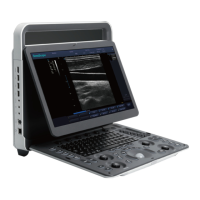10 Probes and Biopsy Brackets
Basic User Manual 123
10.1.2 Probe Usage
●
Use only the probes provided by the manufacturer. Otherwise, the system may not
perform and an accident such as a fire may result.
●
Use the probe carefully. If any part of the probe surface is scratched, immediately stop
using the probe. Otherwise, electrical shock may occur.
●
A legally marketed probe sheath is required for intracavitary operations. If lubricant
is used, it must be water-soluble. Do not apply coupling gel directly on the patient’s
skin. Please dispose of the sheath in accordance with local laws and regulations.
●
Use a sterile probe sheath and sterile coupling gel when performing an intraoperative,
trans-vaginal, trans-rectal or trans-esophageal (Cardiac) exam. If lubrication is
insufficient because of age and personal reason during the exam, you need to apply a
sufficient amount of sterile coupling gel on the surface of the sheath.
●
To avoid contamination, please use the coupling gel and probe sheath before
performing an exam.
●
Use legally marketed coupling gel in accordance with relevant local regulations. Read
and understand all precautions in the relevant manual of the coupling gel before use.
For recommended coupling gels, please refer to Appendix D.1 Coupling Gel.
●
Latex or natural rubber contained inside medical equipments or accessories can cause
severe anaphylactic reactions in some individuals. It’s suggested by the FDA that the
operator should identify latex-sensitive patients and be prepared to treat anaphylactic
reactions promptly.
●
After being contaminated by pathogenic bacterium that is hard to kill, such as
cryptosporidium or prion virus, the probe and its accessories should be destroyed by
melting or burning when necessary because they cannot be completely disinfected or
sterilized.
●
Avoid immersing the transducer surface in the coupling gel for a long period of time.
Otherwise, damage to the probe may occur.
●
Avoid any fluid flowing into the probe or probe connector when cleaning, disinfecting
or sterilizing the probe and probe cable.
■ Special Concerns before Probe Usage
Inspect the probe before each use. If the following damage is found, stop using the probe
immediately.
●
Cracks on the probe handle (user section).
●
Cracks on the transducer surface (applied section).
●
Scratches on the transducer surface (acoustic window surface).

